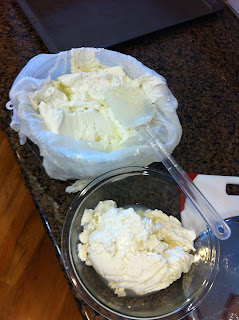1 gallon whole organic milk
Heat to 75 f
Add 20 drops calcium chloride in 1/2 cup water
Add 1/8 tsp mesophilic starter
Ad 1/8 tsp Penicillium candidum
Hold for one hour
Add 20 drops double strength renet in 1/2 cup water
 Leave 12 hours at 70f
Leave 12 hours at 70fCut curd into 1/2 inch cubes
Rest for 30 minutes
Split into two
Ladle into cheesecloth and hang to drain for 12 hours then invert
For additional 12 hours
Use one fresh. Press into a shape mold and cover with
pepper and/or paprika
 |
| Ready for Thanksgiving |
Store one as 2 molds at 50 f for 2 weeks on bamboo
Until a rind forms.
 |
| Firm at 2 weeks - I am guessing another week or two and it would be even better. Mild and buttery, the rind is just blooming. This is a great cheese!!! |








